
Big Plans for Fibre
October 31, 2011
By
Colleen Cross
For many Ontario mills and forestry companies, the wait for fibre is over.
For many Ontario mills and forestry companies, the wait for fibre is over. The province has announced 41 successful proponents in its recent wood competition and has allocated more than 5 million cubic-metres/year of merchantable and unmerchantable fibre. Some key objectives were to free up fibre from shuttered mills and put it to use, as well as to secure more aboriginal involvement in the forest industry.
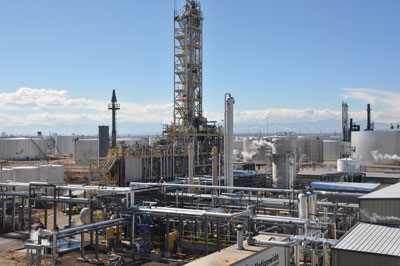 |
|
| A demonstration facility in Colorado that deploys Rentech’s synthetic fuels technology has produced more than 150,000 litres of certified synthetic fuels. Photo: Rentech Inc.
|
“In November 2009, we had a situation where the previous harvest was around 24 or 25 million cubic-metres/year in Ontario,” says David Hayhurst, acting director of industry relations for the forestry division of the Ontario Ministry of Northern Development, Mining, and Forestry. “But because of the economic downturn… we were harvesting less than half of what had historically been harvested.” This led to “an awful lot of unused wood.”
The competition was undertaken in 2009 to see if this wood, much of which was committed or licensed to existing facilities but unused, could be put to other purposes. Of the 8.5 million cubic-metres/year of wood supply available in the competition, about 5.6 million cubic metres/year of wood was offered to successful proponents. Forty-one offers have now been accepted, one is still under consideration, and four were turned down for various reasons.
Wood not offered in the competition is estimated at about 2.9 million cubic-metres/year, Hayhurst says. Because factors such as markets, forest companies, and wood use and availability have changed, the leftover wood supply that wasn’t offered via the competition is being reviewed. Offers that were declined are not being re-allocated, he adds, but rather “de-allocated” in a process known as unencumbering, or reverting back to the previous licence holder.
Among other purposes, the wood is being used to produce lumber, dimension lumber, laminated strand lumber, pulp and paper, utility poles, synthetic jet fuel, naphtha, heat, electricity, mulch, firewood, pellets, and briquettes. Following is just a sampling of many of the biomass-related projects that received allocations.
Electricity
AbitibiBowater is using 317,500 cubic-metres/year of merchantable and unmerchantable spruce, pine, fir, white birch, and poplar to increase pulp and paper production to pre-economic-downturn levels and to generate power at its Fort Frances mill. Another allocation of 291,800 cubic-metres of similar fibre will generate electricity at its Thunder Bay pulp and paper mill.
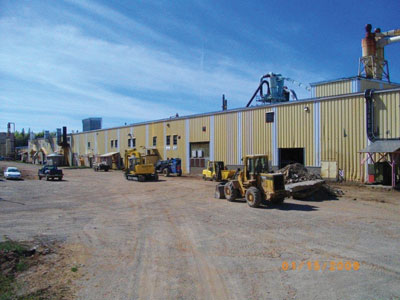 |
|
| Atikokan Renewable Fuels’ converted plant will use pellet presses supplied by California Pellet Mill along with new hammermills and conveying equipment. Photo: Atikokan Renewable Fuels
|
“The company saw the competition as an opportunity to improve the fibre supply to its highly competitive northwestern Ontario assets, diversify its production into pellets, and create fibre supply synergies in the region,” says Pierre Choquette, AbiBow’s director of Canadian public affairs.
A condensing turbine that will produce power for the Thunder Bay mill is currently under construction. Existing equipment consists of two biomass boilers that burn hog fuel supplemented by sludge produced at the paper mill, and one spent liquor recovery boiler. These produce high-pressure steam, running a General Electric turbine and Brown Boveri generator. A purchase order for a new transformer has been issued, mill water tie-ins and piping modifications have been completed, and refurbishment of a power boiler superheater contract has been awarded. The new turbine will produce approximately 40 MW of electricity.
Capital Power’s award of 173,000 cubic-metres of unmerchantable conifer and hardwood will augment the fuel supply to its biomass power plant in Calstock, Ontario, near Hearst, says Mike Long, the company’s manager of external communications. The Calstock plant, which has operated for 10 years, is a steam turbine-driven power generating plant that uses wood waste from the Hearst region as well as waste heat from TransCanada’s nearby Station 88 compressor station. The plant is designed to burn 320,000 green tonnes/year of wood waste, producing up to 35 MW of electricity.
Power is generated using a 41-MW Alstom steam turbine-driven generator. In addition to burning wood waste to produce steam in the biomass boiler, steam produced from the compressor turbine drives waste heat in two Innovative Steam Technologies “once through” steam generators.
Long says the Calstock plant has a 20-year power purchase agreement with the province that expires in January 2020.
Biofuels & biochemicals
One allocation has attracted California-based cleantech company Rentech to White River, Ontario. The company is proposing to establish what it calls the Olympiad Renewable Energy Centre to turn its 1,146,000 cubic-metres/year fibre allocation into 85 million litres/year of low-carbon, biodegradable synthetic jet fuel, approximately 43 million litres/year of renewable naphtha, which can be used to make biodegradable products, and 40 MW of electricity.
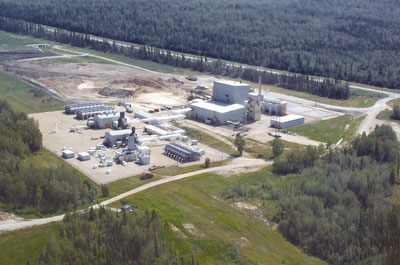 |
|
| Capital Power’s 10-year-old biomass power plant supplies electricity to the provincial grid. Photo: Capital Power
|
Rentech is completing the commercial aspects of the project, including site control and potential offtake agreements, says Julie Dawoodjee, vice-president of Investor Relations at Rentech. It has completed the scoping work and is in the pre-feasibility engineering phase, which includes assessment of potential sites to ensure adequate infrastructure. If all goes according to plan, the company expects to complete the plant in 2015.
“Top priority for us is working through the SDTC [Sustainable Development Technology Canada] application process,” says Dawoodjee. “We need to demonstrate the integrated technology chain that would be used at the Olympiad project.” This requires completion of the demonstration of the Rentech ClearFuels gasifier at the company’s existing synthetic fuel facility in Commerce City, Colorado, which is in many ways, says Dawoodjee, a “mini Olympiad project.” The process involves gasifying biomass and upgrading it to drop-in transportation fuel. Rentech is on track for producing renewable fuels from that technology chain by the end of 2011.
The SDTC, through its NextGen Biofuels Fund, offers potential funding of up to 40% to a maximum of $200 million of eligible project development and construction costs, which would be repaid from a percentage of the completed project’s cash flows.
Dawoodjee notes that the fuel, which is already certified, will be in high demand by commercial airlines facing the potential carbon tax brought about by the EU emissions trading scheme, with changes for airlines coming into effect in 2012. A successful commercial test flight was made in April 2010 using a blend of synthetic jet fuel and conventional Jet-A.
Heat & Power
Olav Haavaldsrud Timber Company is using its 220,000 cubic-metres/year allocation of merchantable wood to expand production its lumber mill. The residuals will supply an adjacent cogeneration facility that’s now under construction. The Becker plant will use a bubbling fluidized bed boiler to burn the residual biomass, producing high-pressure steam that will run an extraction/condensing steam turbine generator.
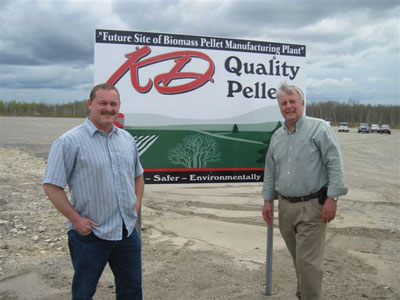 |
|
| KD Quality Pellets president Ken Doupe, left, and Timiskaming-Cochrane MPP David Ramsay at the site of the new pellet plant. Photo: KD Quality Pellets
|
Construction of the partially built cogen plant was briefly suspended while power connection issues were resolved, says Carlo Bin, the company’s president. The company has since reached an agreement with Hydro One on the connection issues, which required some re-engineering. The generating capacity will be 10 MW, down from the original 15 MW. Agreements with equipment providers were in place, but in some cases those contracts may have to be redone. The commercial start-up date is now August 2013.
Under a 2009 request for proposals, the company was granted a contract to sell the electricity to the grid under a CHP-3 agreement. Residual steam will be used for drying and heating purposes at the mill.
For Haavaldsrud, the chance to acquire wood to augment the supply already earmarked for the project was too good to pass up. “We’ve never had such an opportunity in the history of the company to expand our operations, and to the extent that the wood competition allowed,” says Bin.
Heat, power & pellets
Whitesand First Nation, located north of Thunder Bay near Armstrong, is planning to produce 60,000 tonnes/year of pellets, as well as to supply heat and power to three local communities. The cogen facility will initially produce 1 MW, but will have the capacity to increase to 3 MW, supplying Whitesand, Armstrong, and Collins.
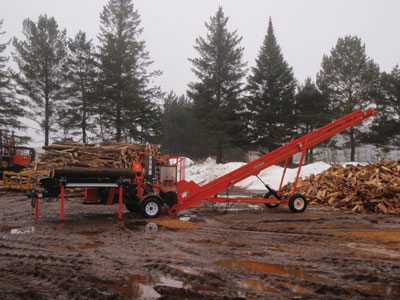 |
|
| A 100,000 cubic-metres allocation of white birch will allow Pays Plat Firewood to launch their residential firewood business, but they are waiting to sign a contractor to harvest the wood. Photo: Multit
|
“I can’t get tired of telling this story,” says Clifford Tibishkogijig, economic development officer for Whitesand. “In 1992, Whitesand First Nation and the community of Armstrong had approached the Ministry of Northern Development, Mining, and Forestry, and the Ministry of Natural Resources, to look at ways of harvesting the Armstrong forest in a more economical and sustainable manner.” Tibishkogijig says they proposed a cogen facility, but the project was turned down. They updated that proposal to meet competition requirements and based some of their argument for gaining a wood supply on the fact it was a revamped proposal.
Plans for the projects are moving quickly. Whitesand has initiated a tendering process for the environmental assessment. Site selection for the cogen facility is in progress, but they must demonstrate that the projects are environmentally and financially sound. The cogen facility will run 24/7 all year, with the existing diesel generating site in Armstrong as a backup power source.
Whitesand is also investigating further commercial and industrial markets for its pellets, including Europe. Up to 25% of its pellets are allocated to industrial use, slated for Ontario Power Generation’s Atikokan generating station, which is being converted from coal. The additional production volume could be industrial or commercial wood pellets, depending on the end-users’ needs.
Construction on the facilities will begin in 2012, with an expected completion date of March 2013.
With its offer of 149,000 cubic-metres/year of merchantable and unmerchantable white birch, poplar, spruce, pine, and fir in hand, the First Nation is now seeking additional fibre. “We are in the midst of negotiating additional volumes over and above what was allocated,” says Tibishkogijig. They have put in a letter of interest for remaining volumes in the Armstrong forest and have initiated an additional market study on some of the softwood species in the Armstrong forest.
Pellets
In addition to producing pulp and paper and electricity, AbitibiBowater is now planning to enter the pellet arena. It has 329,800 cubic metres of its awards earmarked for a wood pellet facility, to be built in the Fort William First Nation Industrial Park, near Thunder Bay. The pellet plant is under development and expected to be operational in late 2013, producing approximately 150,000 tonnes/year.
In nearby Atikokan, another company is also planning to produce wood pellets, about 140,000 tonnes/year worth. Atikokan Renewable Fuels will use 179,400 cubic-metres/year of poplar and birch roundwood, producing pellets for domestic and international customers for heating and electricity.
The company is in the process of converting a former fibreboard plant into a pellet plant. “We hope to be in production in late November or early December,” says Ed Fukushima, president. Construction is underway, with the conversion being done by Great North Bio Energy and Thunder Bay Automation Now.
Combined, Atikokan Renewable Fuels, Whitesand First Nation, and Sandpoint/Nipigon First Nation form the Great North Bio Energy supply chain. They are going after larger projects with their combined volume, says Fukushima. Rainy Lake Tribal Contracting, the company’s aboriginal partner on forest operations, will do some in-woods chipping of the unmerchantable roundwood.
Promising export markets through the St. Lawrence Seaway and the opportunity to supply Ontario Power Generation’s station right in Atikokan are among the reasons behind the conversion project. “The Atikokan Generating Station is being converted to 100% biomass fuel,” says Fukushima. “We’ve submitted an offer to supply there and are bidding on many European and North American supply contracts as a large-volume supply chain.”
Also in the Atikokan vicinity, Wagner Ontario Forest Management Limited, in partnership with Lac Des Mille Lacs First Nation, accepted an offer of 133,500 cubic-metres/year of merchantable and unmerchantable wood fibre.
Wagner plans to build an 80,000-tonne/year pellet plant in Ignace to supply industrial customers. Expected to be operating by October 2013, general manager Rob Edmonds says the company decided to build the plant in response to growing demand for wood pellets. The project is in the early stages, but Edmonds says that grinding and chipping will be contracted out.
Far away, on the eastern side of the province, logging contractor KD Quality Pellets has accepted 90,000 cubic-metres/year of merchantable and unmerchantable timber, also to produce pellets. Targeting both residential and commercial markets, the plan is to produce 75,000 tonnes/year of pellets, bagged for residential customers and bulk for utilities and the European market.
“With the recent decline in the forestry industry, we were looking for something new to do,” says Marc Hamelin, operations supervisor. “In 2008, nobody really knew what a pellet was. It’s changed a lot since then.” The company started to research wood pellets in earnest in 2009 and found them a viable option.
KD Quality Pellets is still negotiating contracts with equipment suppliers for the plant, which will be built from scratch. Although some transportation is in place, the logging fleet will need upgrading to handle the volume. The company will do some of the processing itself, but it will also contract some grinding and chipping from established firms in the area. Much of that processing will be done in the forest. “Most of the timber is unmerchantable, even if it’s standing,” says Hamelin.
Harvesting residues will also fuel a biomass burner that will dry the fibre for pelletizing.
With financial arrangements nearly all in place, the company hopes to start production in May 2012.
Briquettes
While these and more companies are pursuing the pellet market, Millson Forestry Service is producing another type of densified fuel with its wood allocation. Its 57,000 cubic-metres of unmerchantable spruce, pine, and fir, is being turned into about 22,500 tonnes/year of briquettes for domestic and international markets. In addition, with support from the Northern Ontario Heritage Fund Corporation, Millson is putting together a mobile briquette plant, which will be moved to harvest areas to access materials such as tree branches left by forestry operations.
Equipment has been partially up and running since 2007, and the operation is producing on a small scale, says Jeff Morris, supervisor. A standard belt dryer from Waldor Industries feeds the fibre to a hammermill and then a C.F. Nielsen briquetter mounted on a mobile shipping container. All equipment has the potential to go mobile, but right now it is set up at the company’s Timmins location, where staff are working out the bugs. Issues with facility licensing from the ministry are temporarily holding up full-scale production.
The company entered the wood competition to improve its operations. “We are our own first customer,” notes Morris. Millson has been burning biomass for more than 20 years in its greenhouse operation, but with the closing of mills in the area, it was left without a supply of planer shavings to fuel the boiler.
“We quickly realized we needed another option to burn in our boiler. We noticed we were leaving all this slash behind… It doesn’t cost us any more to build the roads, so the more product we can ship out over the roads, the more economical things would become.”
Firewood
For Pays Plat Firewood, its allocation of 10,000 cubic-metres/year of white birch will ensure the fledgling firewood processing and delivery business has a stable wood supply. The company started this past winter but has yet to reach full production. Permits and equipment are ready, but the company is still waiting for the wood. Interim manager and Pays Plat First Nation council member Frank Achneepineskum says that the company needs to secure a cutter for the allocation. Closed mills have meant much less demand for the wood, so they’ve had to wait for wood to be cut and delivered to them for processing. Achneepineskum reports that they have brought three or four transport truckloads so far from nearby Nipigon and Kenogami forests.
The business, which is owned by Pays Plat First Nation, is dependent on the wood supply. It was established to create jobs that don’t require post-secondary education and as a source of revenue for the community.
Because of the delays, they haven’t advertised the product, but Achneepineskum expects a flood of orders once they do. For now, the company’s market is residential. A future goal is to sell to provincial parks.
Print this page